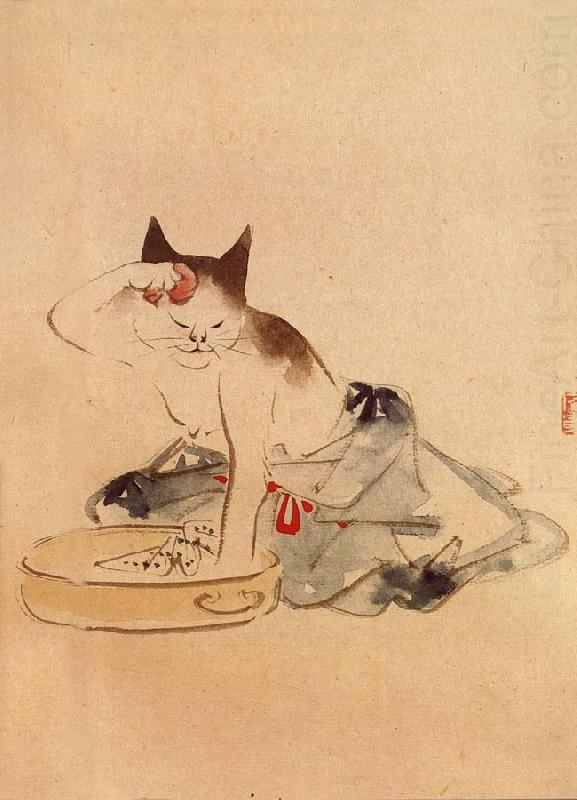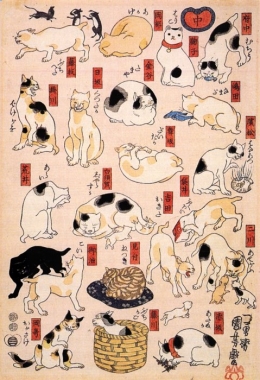Japanese Bob Tailed cats are famous in antique Japanese woodblock prints. *clicking on highlighted words will provide you a link to more information
Many very gifted woodblock artists have included them in their
art. The Japanese Bob Tails have many unique qualities and are have an ancient linage. Their back legs are longer than the front, so they have a characteristic rabbit like hop when running or walking.
 |
| From google for education only |
 |
| Photo by Elizabeth Gordon |
 |
| Hiroshige Print From google for education only |
 |
| Note long back legs, photo of Zafer by Elizabeth Gordon |
 |
| Notice same long back legs as Zafer |
 |
| one of the characteristics is docile, Zafer had that down! |
 |
| Hiroshige was a master artist of the Woodblock Print, this is one of his prints of a Japanese Bob Tailed Cat from google for education only |
totally aloof. He never got overly excited about anything, he looked at it in his cool aloof Dr. Spock manner, seemingly without feeling. But that was just his Zafer Zen, because at night he became a loving sweet boy, purring and sleeping beside us or getting on our chest and rubbing our noses. He never allowed anyone outside of the family to see that side of him, he was a very private man cat. He would be as good a watch dog as Vinci, the terrier, hearing when the gate opened or a car door closed. He was alert and would always here the engine of your car and greet you by the front door when you came home. He was exceedingly fond of food and never tolerated missing a meal or his nightly treats. He tolerated the other house cats and better tolerated our dog, but he was a reclusive choosing to hang out in the garden grasses or on the bed in the sunlight.
 |
| Utagawa, Japanese Woodblock Master Artist |
He had a round pink belly, pink ears and a pink nose..like a rabbit might have. He was more panda like and rolly polly than sleek.
 This week we suddenly lost our sweet boy of 15 years, our Japanese Bob Tail. He became ill overnight, and the next day the news from the vet was terrible, "too much wrong, too much to overcome!" In two hours time we had to go from a vet visit to putting him down for humane reasons. Ann held him, and I petted him while the vet administered the drug. It went fast and just like that the life of our dear furry child was gone. 15 years of snuggles and companionship gone. But we are richer for having had one Princely Japanese Boy in our life and we will always feel loved by a special boy with a special linage…our rabbit cat!
This week we suddenly lost our sweet boy of 15 years, our Japanese Bob Tail. He became ill overnight, and the next day the news from the vet was terrible, "too much wrong, too much to overcome!" In two hours time we had to go from a vet visit to putting him down for humane reasons. Ann held him, and I petted him while the vet administered the drug. It went fast and just like that the life of our dear furry child was gone. 15 years of snuggles and companionship gone. But we are richer for having had one Princely Japanese Boy in our life and we will always feel loved by a special boy with a special linage…our rabbit cat!

 |
| Hiroshige print and drawings of the ancient Japanese Bob Tail Cat |
"There are many references to short-tailed cats in Japanese folklore, including the story of a cat whose tail caught fire from a spark from a nearby heart. The jittery cat ran hither and yon, and set fire to houses in the Imperial city. In the morning the city was razed to the ground and the Emperor, seething with anger, passed a decree that the tail of all cats was to be chopped short to prevent another mishap.
There is also the legend of maneki-neko, the "beckoning cat" that attracted many passerby; so much so, in fact, that its figure is now considered a symbol of good fortune in storefronts and homes. The facade of the Gotokuji Temple near Tokyo also depicts a representation of the cat, which seems to raise one paw as a sign of welcome.
Domestic cats came into Japan from China and Korea around the 6th century, though it is not known whether these cats possessed the hallmark short tail of the Bobtail.
In the 17th century many Bobtails roved the streets and countryside of Japan. There are even paintings and woodcut prints from the era depicting tri-colored cats with short tails. Most often referred to in Japan as mi-ke, the cats are white with bold patches or red and black. They were revered by the Japanese, who provided them with luxurious and pampered lives in temples and palaces.
However, the fate of the cats would forever be changed when the Japanese silk industry was threatened. When mice began destroying precious silk worms and cocoons on which Japanese silk industry thrived upon, the government declared that all cats be set free to counter the menace. The Bobtail, then forced to fend for itself on the street, was relegated to a common domestic cat."
source: from Pawnation article
 |
| Woodblock by Utagawa from google for education only |


No comments:
Post a Comment